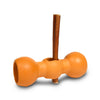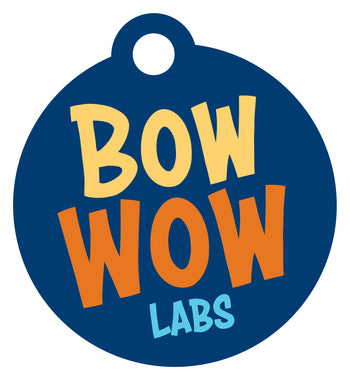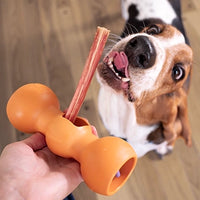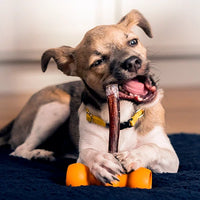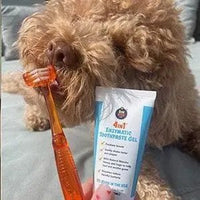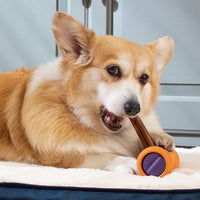Dental care is much more important than many pet owners may realize, or want to believe. It’s estimated by the American Veterinary Medical Association that 80% of ALL dogs over the age of 3 years old have some sort of oral or periodontal disease, which, without lifestyle changes, will worsen as pets age. Unaddressed oral or periodontal disease can in time affect the body’s major organs, including the heart, liver, and kidneys(1). This is because the bacteria found in the mouth can lead to inflammation beyond the mouth and into distant organs.
Fortunately, dental care is a quick and easy way to reduce the risk of periodontal issues. If your dog has never had their teeth brushed, that doesn’t mean it’s too late to start. Any added dental care is purely beneficial to your dog’s overall health. Plus - brushing isn’t the only way to add dental care to your dog’s daily routine. In this blog, we’ll cover all the ways you can make a positive impact on your dog’s dental care, plus, our “Real Person’s Guide” to starting a tooth-brushing routine with your dog.
Dental Care Basics for Dogs
Consider your adorable pet’s ancestors for a moment - what would they have eaten in the wild? Dogs' bodies were designed to eat the entirety of their prey – including fur, bones, and strong elastic tissue. These tougher parts of the prey would have provided a natural brushing effect as dogs instinctively chew. While we can’t (and really, really just don’t want to) provide our dogs with live prey animals to eat, we can replicate this effective brushing by way of chewing. Providing your dog with hard, natural chews like bully sticks or raw beef marrow* or knuckle bones can help prevent plaque and tartar formation. The act of chewing makes the object scrape against the teeth and gums, creating a natural brushing effect. Aim for three 30-minute chewing sessions a week at a minimum for the highest benefit. Change up the chews with other hard, natural options like yak milk cheese chews, natural shed split antlers, or collagen sticks to provide a range of nutritional benefits at the same time!
Diet can also have an impact on your dog’s periodontal prowess - poor diet can directly impact dental health. If your dog’s diet is lacking, their saliva’s chemical makeup can change and contribute to tartar buildup. Feeding your dog a high-quality diet, especially one that includes fresh foods will benefit more than just their oral health – it will also positively impact their overall health.
Lastly, keeping an eye on your dog’s teeth yourself can never be overrated. As you develop a daily brushing routine, look at their individual teeth, examine their gums, and take note of their breath. Red or swollen gums, lumps or bumps along the jawline, and foul odors should lead to an immediate call to the vet.
The Real Person’s Guide to Brushing Your Dog’s Teeth
We know how beneficial a few moments of teeth brushing can be for your pet- but actually picking up the brush for the first time is a tough hurdle for many dog owners. These behavior-driven steps are quick and easy to work into your dog’s daily routine, and slowly progressing onto each new step will allow you and your dog to gain trust and confidence in one another in your new, shiny-toothed adventure.
Some important tips before getting started: Ease your dog into it – start with 30 seconds a few times a day with each step. Progress to a minute (it won’t take this long once your pup is comfortable) 2-3 times a day, and only at that stage, move on to the next. Work as a team - don’t force your dog to accept these new actions or hold them down, as they will create negative associations with toothbrush time, and make them less likely to progress to the next steps of acceptance.
If your dog shows hesitation or resistance, move back to the previous step for a few days, or reduce the time spent on step 1, and build back up as your dog becomes comfortable. With patience and persistence, your dog will become used to these new actions and accept brushing as part of their daily routine.
Step 1: Play with their lips
Take your pup’s upper lip between your forefinger and thumb and gently massage for a few seconds. Then move to a different position and resume massaging. Your goal with this step is to get your dog accustomed to having their mouths touched..
Step 2: Feel their gums
Once your dog is comfortable with their lips being manipulated, start gently touching their upper and lower gums with the same intent as their lips in the step prior. Get them used to the sensation of fingers being inside their mouth.
Step 3: Massage their gums
Once you can confidently touch your dog’s upper and lower gums, we go a step further to desensitize them to movement within their mouth. Gently place your finger inside their mouth and ‘massage’ the upper gums for 3-5 seconds. If your dog allows it, do the same on the lower gums and in different positions around the mouth. Try alternating top and bottom, left and right throughout different times of day as they become accustomed to this sensation.
Step 4: Brushing time!
Be sure to select a toothbrush that is both soft and appropriate for the size of your dog’s mouth. Allow them to sniff the toothbrush before lifting their lip. Like we did in step 3, start out slowly and gently massaging the gums, and start to brush their teeth. Keep it short and sweet - 30 seconds to a minute puts you in the “All Star'' category of periodontal pet parents!
Step 5: Tease their taste buds
There are a number of toothpastes on the market that not only taste great to dogs, but also are free of artificial ingredients - choose an enzymatic toothpaste with soothing ingredients like aloe and manuka honey to naturally calm oral inflammation while cleaning.
Step 6: Make it a habit
Ideally, make brushing a part of your everyday routine. Once your dog is comfortable, only 20 seconds or so are needed each day. Brush your dog’s teeth immediately after brushing your own for an easy reminder- after all, we all need to remove bacteria and biofilm before it becomes plaque!
It takes time to adjust - be patient and work as a team!
Dogs take time to adjust - work with them as a teammate rather than an opponent you’re trying to overcome. Work with them as they naturally try to bite the toothbrush, and if they will not accept a brush in their mouth, try a piece of gauze or a cotton square over your finger to get some brushing action. Never force their jaws open, even to clean the inside of their teeth - instead, look for a toothbrush with multiple brushing heads to clean both sides of the teeth in one pass.
*Never feed dogs cooked or inappropriately sized bones
1: https://www.avma.org/resources-tools/pet-owners/petcare/pet-dental-care
Related Products:
https://www.bowwowlabs.com/collections/oral-care-products/products/oral-care-starter-kit-large
About the Author: Johnna Devereaux is a Clinical Pet Nutritionist, canine wellness expert and the Chief Nutrition Officer for Bow Wow Labs. Johnna’s unique perspective and wealth of knowledge about dog nutrition and wellness empowers people to make educated decisions about their pet’s overall nutrition. She brings years of experience in holistic animal health to our Wellness Center.
The points of view expressed above are those of our Chief Nutrition Officer and supported by science, her education and experience. However, we recognize there may be different points of view or opinions on some aspect or even the premise of this article. Our goal at Bow Wow Labs is to provide the best, clearest, and most helpful information possible to help keep your dog happy, healthy and safe.


